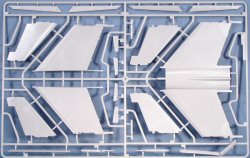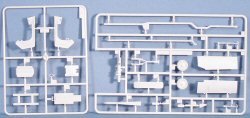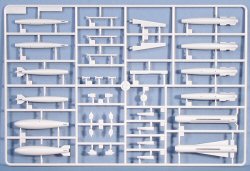
Trumpeter 1/32 A-7E Corsair II Kit First Look
By Michael Benolkin
| Date of Review | December 2005 | Manufacturer | Trumpeter |
|---|---|---|---|
| Subject | LTV A-7E Corsair II | Scale | 1/32 |
| Kit Number | 2231 | Primary Media | Photo-Etch, White Metal, Styrene |
| Pros | Nice cockpit, avionics bays, external stores options | Cons | |
| Skill Level | Intermediate | MSRP (USD) | $139.95 |
First Look
 |
 |
 |
 |
 |
 |
 |
 |
 |
 |
 |
 |
 |
 |
 |
Here we go again! Another awesome release from Trumpeter. Who would have ever imagined we'd have a SLUF in 1/32 scale? This kit is absolutely beautiful.
In the early 1960s, the US Navy held a competition to develop a light attack aircraft with better avionics and payload capabilities than the A-4E Skyhawk. The Navy threw in a catch - the design must be based on an existing aircraft in order to expedite production. Ling Temco Vought (LTV) was the winner with their A-7 based on their successful F-8 Crusader. To facilitate the A-7, LTV designers stripped off several key features of the F-8.
The afterburning J52 was replaced with the more fuel-efficient TF30 turbofan, eliminating the extra fuselage length for the afterburner section. Since the aircraft was therefore shorter, the variable incidence wing was eliminated as tail ramp strike wasn't as much of an issue. As the aircraft was subsonic, the hump behind the cockpit which was an area rule 'bandaid' applied to the F-8 was no longer necessary. Six weapons stations were added to the wings while the A-7 retained the F-8's fuselage-mounted Sidewinder rails. Of course, on paper these changes were a simplification of the existing F-8 design, but in production, the A-7 Corsair II was a new aircraft. Aircrews dubbed the aircraft the SLUF - Short Little Ugly 'Fella'.
The A-7E was the final US Navy single-seat development of the Corsair II family. It received an improved-thrust TF41 engine, replaced the two 20mm cannons with a single M61 Vulcan 20mm gatling gun, and featured updated avionics. The A-7 saw combat early in its operational life over Vietnam, and ended its career over the skies of Iraq during Operation Desert Storm. It even had the distinction of tapping a Libyan SA-5 SAM site with HARM missiles when a pair of SLUFs crossed the "Line of Death" in the Gulf of Sidra to pay their respects. The A-7 was in the process of being phased out of service in favor of the F/A-18A Hornet when Operation Desert Shield/Desert Storm were happening, and the two squadrons that flew the SLUF with great combat results in Iraq transitioned to the Hornet on their return home.
Molded in light gray styrene, the kit consists of 678 parts and is presented on 22 parts trees (duplicate trees not shown) plus two small trees containing the clear parts and separately protected canopy and windscreen. In addition, the kit features two frets of photo-etch, rubber tires, and white metal landing gear struts.
At first glance, the cockpit tub looks rather plain, but with the separately molded side consoles and the nice instrument panel, the cockpit looks right. Even the ejection seat is done well, complete with photo-etched seatbelts and harnesses.
The main wheel wells are quite busy with the plumbing and the various pressure bottles inside, very nicely done!
Like the 1/48 Hasegawa SLUF, this kit features open port and starboard avionics bays with all the 'black' boxes in view.
The kit features a nice-looking M61 Vulcan for the port-side nose, but all you'll ever see are the tips of the barrels.
The kit has some very nice detailing in and around the fuselage, including the styrene and photo-etch fuselage stiffeners that run under the wings. The way this kit is laid out, it would be a no-brainer to add the air refueling receptacle 'hump' to the box and render an Air Force A-7D. Speaking of air refueling, the kit has the Navy-styled refueling probe, but it is provided in the stowed position only. You'll need to do a little modifying to get the probe out to render the proper 'salute' to your friends.
The wing goes together very straightforward as is its mounting on the fuselage. There should be no surprises here. The leading and trailing edge flaps look to be positionable (separately molded) but the instructions show them installed up and locked. When has that stopped anyone... The six underwing weapons stations are also nicely rendered down to the anti-sway braces.
The main landing gear is provided as white metal or styrene (your choice) while the nose gear is heavy duty enough to be styrene.
Here's one option that I'm not too certain what they were thinking about - the ventral speed brake can be positioned open. The hydraulic ram definitely poses that speed board all the way out. This is great if you're posing the model in flight (though you'll need to rework the landing gear to look unloaded or simply raise them, close up the avionics bays, and find a pilot) but the SLUF sits low to the ground and if I recall the A-7D Dash One correctly, the speed brake is not available when the gear is down to prevent a crunching metallic sound when landing.
The outer wing panels can be posed folded or unfolded.
The external stores in the kit are equally impressive. You have two external fuel tanks for stations 3 and 6. An optional LANA (Low Altitude Night Attack) pod included to replace one of the external fuel tanks. In addition, the kit provides:
- 2 x AIM-9D/G/H Sidewinder
- 2 x GBU-8 HOBOS
- 2 x GBU-10 Paveway
- 2 x AGM-12 Bullpup
- 2 x AGM-45 Shrike
- 2 x AGM-62A Walleye
- 6 x AGM-65 Maverick
- 2 x AGM-84E SLAM
- 2 x AGM-88 HARM
- 12 x Mk.82 Snakeyes
- 12 x Mk.82 Slicks with and without fuse extenders
- 6 x Mk.117
- 2 x TER
- 2 x MER
Update: I was enjoying my lunch and looking over the review from the office when I spotted a two missiles not on the above list. There are two AGM-88 HARM and two AGM-84 SLAM included in the kit, but not mentioned in the instructions (I double-checked!). At least there are stencils for both pairs on the weapons decal sheet. While I was at it, something about the AIM-9Bs didn't look right since the K-13 (AA-2 Atoll) is a copy of the AIM-9B and that isn't a K-13. A quick check of the tech orders confirm that the missiles are US Navy AIM-9D/G/H Sidewinders. If you want AIM-99Bs, go raid your Trumpeter MiG-21. The above weapons list has been updated.
I also reviewed the parts trees on the off-chance that there was an Air Force air refueling receiver there and also not mentioned, but no such luck. Two other points are present at second glance. The curved air intake duct is similar in design to the Hasegawa duct in their 1/48 scale kit, including the absence of a compressor face (though you really have to work at seeing anything down that duct). The TF30 turbine face at the rear will definitely need to be replaced.
There are two huge decal sheets included in this kit. The first one contains markings for two aircraft options:
- A-7E, BuNo 159289, VA-82, AJ/300, USS Nimitz, 1978
- A-7E, BuNo 157530, VA-192, NH/300, USS Kitty Hawk, 1972
Both aircraft are CAG birds, so you're getting colorful subjects to start with.
The other decal sheet is nothing but weapons stencils. Lots of weapons (and pylon) stencils. This is going to be one beautiful aircraft with all of this!
As usual, this is an incredible work of art. Trumpeter has certainly done it again. Add this awesome array of armament, and you're going to want more than one of these kits. This one is definitely recommended!
I wonder if we can get Trumpeter to re-release these weapons trees and decals as separate weapons kits? Wouldn't that be handy?
My sincere thanks to Stevens International for this review sample!







